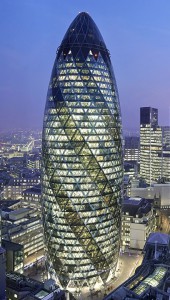
SENA KAYASÜ (ARCH/IV)
sena.kayasu@ug.bilkent.edu.tr
There is a lot of debate about what constitutes Architecture with a capital “a.” It’s a difficult question to answer, because no one knows what the question is. Are we looking for a building that makes people feel awed? Safe? Inspired? All of the above? Or something else entirely?
Everyone has their own opinion about the question and its answer. My answer—right now—is the Gherkin in London. It’s my favorite building even though (or perhaps because) I have never been there to see it. But from a design point of view, it’s perfect.
And what it is that makes a design perfect? Consistency. There are many different aspects of any building, among them its structure (how it stands up), its form (what it looks like) and its circulation (how people move around in it). What makes good design is each one of these elements fitting with the others, illustrating a larger idea or understanding that generated them all. Then it has meaning. Then it is Architecture.
 This happens in the Gherkin. The design firm, Foster + Partners, utilized a diagrid (diagonal grid) exoskeleton that forms the structure and characterizes the building. It allows for a more liberated, circular form. On each floor, the slab rotates five degrees to create two- or three-story spaces and provide room for breathing. Some of the rotations allow for diagonal channels that wrap around the building (in height) to create spaces that rise through the entire height of the structure to house ventilation ducts and channels for fire intervention. The five-degree rotation that repeats over 41 stories is justified by the innovative structural system, the diagrid. The building’s circulation is generated from this. The egg-shaped form is generated from it. It is so characteristic that the Gherkin has become one of the most easily recognizable features of the London skyline.
This happens in the Gherkin. The design firm, Foster + Partners, utilized a diagrid (diagonal grid) exoskeleton that forms the structure and characterizes the building. It allows for a more liberated, circular form. On each floor, the slab rotates five degrees to create two- or three-story spaces and provide room for breathing. Some of the rotations allow for diagonal channels that wrap around the building (in height) to create spaces that rise through the entire height of the structure to house ventilation ducts and channels for fire intervention. The five-degree rotation that repeats over 41 stories is justified by the innovative structural system, the diagrid. The building’s circulation is generated from this. The egg-shaped form is generated from it. It is so characteristic that the Gherkin has become one of the most easily recognizable features of the London skyline.
The lead designer was Sir Norman Foster: the pride and glory of the United Kingdom. Perhaps it is wrong to call the building his when the diagrid idea probably came from Arup, the engineering company for the project. But the architect is the unifier; he puts everything together and takes credit for it. Such is life.
So many factors go into creating a building that it would make anyone’s head spin. The Gherkin, officially known as 30 St. Mary Axe (and formerly as the Swiss Re Building), was built in a city that draws strict limits for its future because of the respect it harbors for its past. The structure was commissioned to be built on the site of the old Baltic Exchange. This area was meant for the proposed Millennium Tower, which was envisioned as being much taller. But the tower was too tall. So the authorities said, “Scratch that, we’ll build something else.”
Plus, they now became nicer about the rules. London, like many well-organized and historic metropolitan areas, has a thing about building height. They love the ancient St. Paul’s Cathedral and want it to rule over the city, so an edifice needs to have very special permission if it’s in the Cathedral’s line of sight. As it turned out, the site in question was not, in fact, in the sight line. It was also in a part of London that needed rejuvenation. So the original constraints that had doomed the poor Millennium Tower were removed.
The architect who got the job would instead have a new challenge: create a landmark. He would be given a free hand in the design. The building was to house the offices of a reinsurance company (Swiss Re), but the authorities did not want a large, boring, cubic bank. They even gave up on their desire to maintain London’s traditional streetscape, with its relatively narrow streets. So why not have a building that had its equator above the street level?
So they did. The building has an arcade to invite people to interact with it. It fattens toward the middle. The top is the closing point for the grid. It celebrates this position with a bar that has a panoramic view of London.
People who are not daily occupants of the building are encouraged to visit it for the view. Aside from the bar, there are decks on the lower floors that are just for visitors. The view is accessible everywhere because the diagonal steel frame was able to be completely enclosed by glass: 745 huge pieces of it, in fact. And though the structure is egg-shaped, only one of those pieces is actually curved. Which is pretty awesome.
Despite all the glass, the Gherkin consumes only about half the energy that another structure its size would use. This is because the gaps in each floor create shafts that serve as natural ventilation channels, and the glass lets in enough sunlight in the right places to both heat the interior and provide natural light.
All in all, 30 St. Mary Axe begins and ends with its diagrid system. It is defined by it. It is consistent and inventive enough to have received the first RIBA Stirling Prize, given by unanimous decision in 2004. Its cost was 200 million pounds, but it made Swiss Re a 300 million-pound profit when it sold for 630 million in 2006. In November last year, it resold for 700 million. It currently has 14 tenants, with the top two floors beneath the bar being available (for anyone who is interested). It has become almost as recognizable a symbol of London as the Tower Bridge. Architecture.
